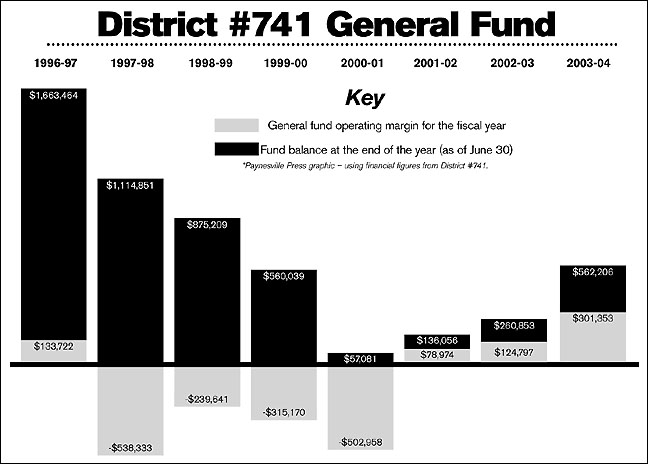District operates in black again
"We're moving in the right direction, which is good," said superintendent Todd Burlingame about the district's financial situation.
In the 2003-04 school year, which ran from July 2003 to June 2004, the district had general fund revenues of $8,742,562 and expenditures of $8,423,209, yielding an operating margin of $301,353, the largest for the district in eight years.
 The district's general fund balance was $562,206 - as of July 1, 2004 - the highest for the district since July 1998. The district had a similar general fund balance in July 1999, but it was then in the midst of five straight years of deficit spending, leading the district to be in statutory operating debt following the 2000-01 school year.
The district's general fund balance was $562,206 - as of July 1, 2004 - the highest for the district since July 1998. The district had a similar general fund balance in July 1999, but it was then in the midst of five straight years of deficit spending, leading the district to be in statutory operating debt following the 2000-01 school year.
Since then, the district has operated in the black: $78,974 in 2001-02, $124,797 in 2002-03, and $301,353 in 2003-04.
The district's general fund balance represents six percent of the district's general fund budget, estimated at $8,514,397 for 2004-05. The school board has set a goal to have a fund reserve equal to one month's expenses, or just over eight percent. And, the general fund balance ($562,206) includes ($179,072) in designated funds and ($88,054) in the Carol Weaver Trust Fund, meaning the unrestricted general fund reserve ($295,081) amounts to only three percent of the 2004-05 general fund budget, only a couple week's worth of expenses.
Still the audit, revealing that the district is making progress in rebuilding its reserves, is good news. "Next year, I hope our audit is as good as this one," said Burlingame. In his first year as superintendent, Burlingame said the credit for this audit really should go to retired superintendent Howard Caldwell and the school board.
The district's final 2003-04 budget predicted a deficit of $55,000, so the audit revealed a favorable variance of $356,000, with the district actually running in the black by $301,353.
When asked whether the board should be concerned about that variance, auditor Al Habben told the school board that there is no set standard for budget variance; it is just a management tool.
Burlingame, who helped Caldwell with the 2004-05 budget, said the budgeting process for schools is backwards. Schools must have a budget in place by July 1, but they normally don't have all contracts settled, they don't know about state funding, and they don't know their enrollment.
Keeping a margin - this year's variance represented four percent of total revenue - is prudent, according to Burlingame. "We don't want any surprises. We want to be conservative and to be fiscally responsible," he said.
At last week's school board meeting, in addition to reviewing the 2003-04 audit, the school board authorized having administration prepare budget adjustments for the 2005-06 school year.
The district's long-term budget prognostication still runs in the red. Burlingame calls this a worst-case scenario, but stagnant state funding combined with enrollment declines means the district needs to continue to be vigilant with its dollars.
Right now, the district averages 98 students per grade in its five top grades (8-12), but it averages only 76 students per grade in its bottom eight classes (K-7). Opening-day student enrollment was 1,099 in 2004-05, but district projections show student enrollment dropping under 1,000 if this trend continues.
For the next five years, if 98 graduates are replaced with 76 new students, the district stands to lose $115,000 in revenue per year due to declining enrollment at the current per-pupil state payment rate.
"Basically, the bottom line is kids equal dollars. As our enrollment declines, our revenue declines," explained Burlingame.
Administration is expected to take a couple months to make a budget adjustment proposal for 2005-06. They will use a similar procedure as last year, said Burlingame, when one principal position and two teaching positions were eliminated, netting about $180,000 in budget savings.
The long-term district financial plan calls for $250,000 in budget adjustments for 2005-06, but that total amount may not be feasible, said Burlingame. The administration will try to be fiscally responsible and make needed budget adjustments, while maintaining a good, wide-ranging program.
This "balancing act," said Burlingame, gets tougher as the small classes move into the middle and high school. The elementary school has already seen major cuts, as each grade has been reduced from four sections to three sections.
But while reducing the sections in eighth grade from four to three next year - the 82-member seventh grade class has been the first class to be divided into three sections instead of four throughout the elementary and middle school - other reductions are more complex in the high school since classes are taught by subject and driven by student demand.
Administration will be better able to recommend budget adjustments to the school board following registration for high school classes in February (after which the district will be able to figure its needed staffing for 2005-06) and following kindergarten round-up (which has been moved to February so the district has a better idea of its kindergarten enrollment next year).
Also, the district will know by March 1 which teachers plan to retire this year and can decide which positions need to be replaced. "It's a lot easier to make reductions through attrition," Burlingame said.
Contact the author at editor@paynesvillepress.com • Return to News Menu
Home | Marketplace | Community